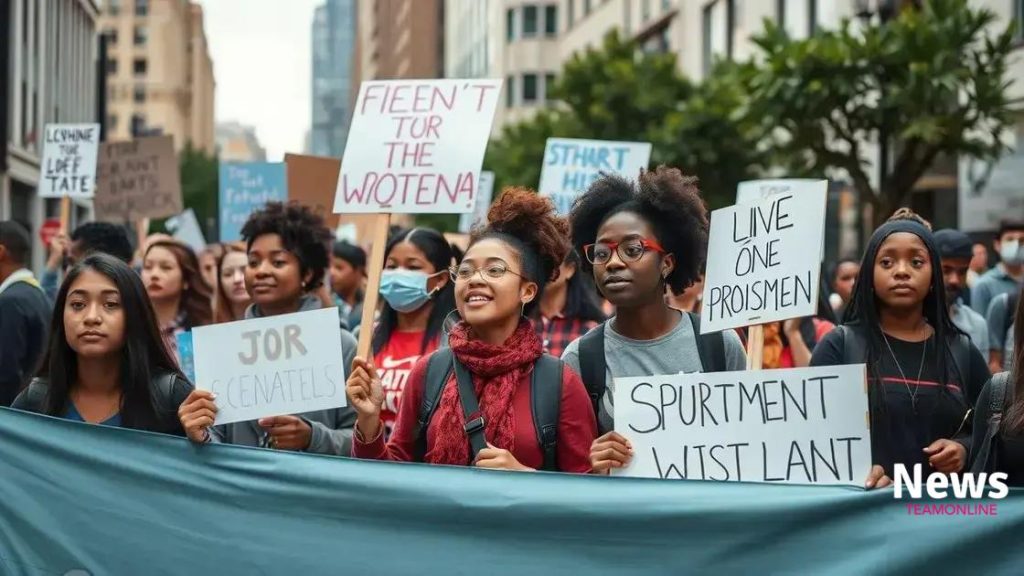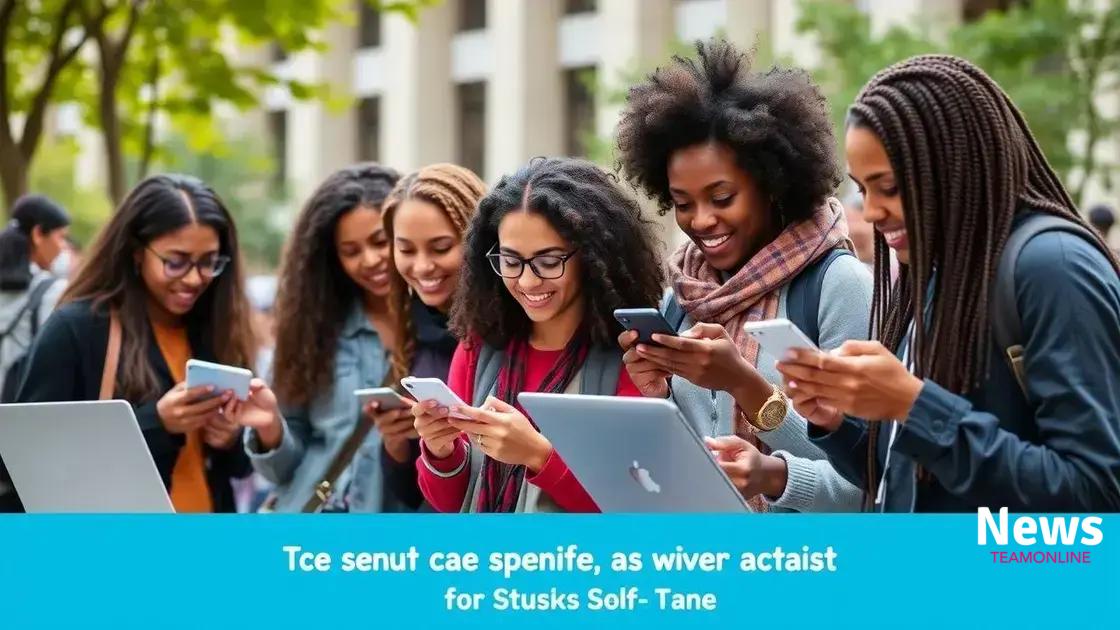Rising influence of student activism in today’s world

The rising influence of student activism is reshaping policies and social issues globally, driven by diverse voices, effective use of social media, and a focus on critical topics like climate change and social justice.
Rising influence of student activism is changing the landscape of social movements. Have you noticed how young voices are stepping up and demanding attention? In this article, we’ll dive into how students today impact society and drive significant changes.
Understanding the roots of student activism
Understanding the roots of student activism is crucial to grasp how these movements shape our society today. Student activism has a rich history influenced by social, political, and economic factors.
Historically, youth have been at the forefront of social change. From the civil rights movement to anti-war protests, students have often played pivotal roles. Today, many students are mobilizing for various causes, demonstrating their power to effect change.
The 1960s: A Turning Point
The 1960s marked a significant turning point for student activism. College campuses became hotbeds for political engagement. Students protested against the Vietnam War, advocating for peace and justice. This era highlighted the potential of youth to influence national discussions.
Key Influences on Student Activism
- Social media: Accelerated information sharing and mobilization.
- Economic inequality: Fueling anger and demand for change.
- Diversity: Highlighting unique perspectives and broadening causes.
Today, the roots of student activism continue to evolve. Issues like climate change are now central, as students recognize the urgency of their collective voice. The evolution of technology has made organizing easier, allowing students to connect globally.
Many modern movements highlight how students are not just passive observers but active participants in shaping policy and public discourse. As they raise their voices against injustice, they prove that their influence is growing, and the future is in their hands.
Key movements led by students
Key movements led by students have significantly influenced society and policy. Over the years, young activists have become the driving force behind important changes.
One of the most notable movements began in the late 1960s during the Vietnam War. Students organized protests and rallies, calling for an end to military involvement. Their voices resonated across campuses and set a precedent for future activism.
The Civil Rights Movement
Another pivotal moment is found in the Civil Rights Movement. Students joined established leaders and organized sit-ins, marches, and campaigns for equal rights. Their energy brought attention to the injustices faced by African Americans and other marginalized groups.
Recent Movements
- Climate Activism: Fueled by figures like Greta Thunberg, students around the globe have mobilized for action against climate change.
- Gun Control Protests: Following tragic shootings, students have emerged as fierce advocates for stricter gun control laws.
- Fight for LGBTQ+ Rights: Students have been at the forefront of advocating for equality and acceptance within educational institutions.
Through social media platforms, these movements have gained global attention quickly. Student leaders harness technology to organize, share information, and inspire others. Their collective efforts highlight the importance of youth voices in addressing societal issues.
As they challenge the status quo, students continue to demonstrate that they have the power to influence change. The legacy of their activism sets a powerful example for future generations.
The role of social media in organizing

The role of social media in organizing student activism cannot be overstated. Platforms like Twitter, Instagram, and Facebook have transformed how students mobilize and share their messages.
One key benefit of social media is its ability to connect students across vast distances. Activists can now communicate and collaborate instantly. This rapid exchange of ideas fosters a sense of community among young people advocating for change.
Mobilizing for Events
Social media serves as a powerful tool for mobilization. Students use platforms to promote events, such as protests or awareness campaigns. Hashtags often trend, reaching broader audiences quickly. This visibility is crucial in gaining support and attracting media attention.
Spreading Awareness
- Real-time updates: Students share live updates during events, keeping supporters informed.
- Visual storytelling: Images and videos capture the essence of protests, making issues relatable.
- Engaging content: Memes and infographics are shared widely, simplifying complex topics.
These aspects of social media help create a sense of urgency around various issues. When students see their peers addressing critical topics, they feel motivated to join the cause. The power of viral content can spread messages far beyond local communities.
Moreover, social media provides a platform for marginalized voices. Students who may not have been heard in traditional media can share their perspectives and experiences. This inclusivity enriches the conversation surrounding activism and ensures diverse viewpoints are represented.
Impact of student activism on policy changes
The impact of student activism on policy changes has been significant throughout history. When students raise their voices, they often influence decision-makers and bring about real change.
Many recent movements have showcased how student-led initiatives can force institutions and governments to take action. For example, the fight for climate action has seen students pushing for policies to reduce carbon emissions and promote sustainability.
Recent Examples of Influence
In the wake of school shootings, students have mobilized to advocate for stronger gun control laws. Their powerful speeches and organized marches have brought increased attention to this critical issue, resulting in debates about necessary reforms.
Key Strategies Used by Activists
- Organized protests: Students gather to demonstrate their demands publicly.
- Petition campaigns: Collecting signatures to show widespread support for changes.
- Lobbying lawmakers: Engaging directly with officials to discuss their concerns and push for specific legislation.
The role of social media amplifies these efforts. Activists can share their stories and mobilize support quickly across various platforms. This broad reach allows their messages to resonate with wider audiences and creates pressure on policymakers.
Moreover, as educational institutions recognize the importance of student voices, they often partner with activists to discuss relevant issues. Such collaborations highlight the need for more inclusive decision-making processes that consider the perspectives of younger generations.
Future trends in student activism
Future trends in student activism are evolving as young people become increasingly aware of global issues. With ongoing challenges like climate change and social justice, students are expected to take a central role in shaping future movements.
Innovation in technology also influences these trends. As access to technology grows, so does the ability of students to organize and share information instantly. This enables rapid mobilization around causes. Social media platforms will continue to play a pivotal role, making it easier for activists to connect and collaborate.
Increased Diversity in Activism
We can expect a broader range of voices in future activism. Different communities are sharing their unique perspectives on issues, providing a rich tapestry of ideas. This diversity can drive more inclusive and comprehensive solutions to societal challenges.
Focus on Global Issues
- Climate change: Students are leading the charge for environmental sustainability through local and global initiatives.
- Social justice: Movements addressing racial, gender, and economic inequalities are on the rise.
- Digital rights: As technology advances, students will advocate for privacy and ethical use of data.
Activism will also become more intersectional, recognizing that different issues are interconnected. This means that movements will likely unite various groups to address multiple concerns at once.
As students become more politically engaged, they may influence the agenda in schools and towns. The push for more curriculum on social issues can help educate future generations about civic responsibility and activism. We can expect educational institutions to adapt to these demands, fostering environments that encourage critical thinking and engagement.
FAQ – Frequently Asked Questions about the Rising Influence of Student Activism
How does social media impact student activism?
Social media allows students to connect, organize, and spread their messages quickly, increasing their reach and influence.
What are some key issues that student activists focus on?
Student activists often focus on climate change, gun control, social justice, and digital rights.
How do students organize protests effectively?
Students use online platforms to share information, create events, and gather support through petitions and social media campaigns.
What is the future of student activism?
The future of student activism looks promising as young people become more engaged with global issues and use innovative strategies to advocate for change.





